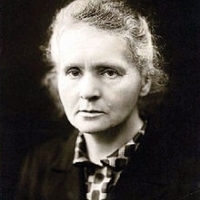Marie Curie and the radioactivity, The 1903 Nobel Prize in Physics
Radioactivity
Marie Curie
Research field: Physics and chemistry
Born:1867, Warsaw, Russian Empire (now Poland)
Died:1934, Sallanches, France
Awarded the Nobel Prize in Physics 1903 and the Nobel Prize in Chemistry 1911.
When Maria Sklodowska was growing up, Poland was occupied by Russia and the Russian Tsar decided that women should not study at university. Maria's parents were teachers, and she had four siblings. Maria had the highest grades in school when she was 15 years old, but suffered from “nervous disorders” and felt so tired she could not do anything. Finally Maria and her sister Bronya succeeded through hard work to get an education abroad.
Nearly 24 years old, Maria, or "Marie" in French, began her studies at the Sorbonne University in Paris. She studied physics and mathematics on a postgraduate scholarship. The only thing missing was a laboratory to do her research, but that problem was solved when a laboratory manager called Pierre Curie offered her a place. A year later, in 1895, they married.
Nobel Prize-awarded discoveries
That same year, French physicist Henri Becquerel discovered that minerals containing uranium emitted a strong radiation. Marie became interested in this discovery, and found a way to make precise radiation measurements. The more uranium the minerals contained, the higher strength radiation. Marie also found this radiation in minerals containing the element thorium.
Marie called this radiation radioactivity - "radio" means radiation. She noted that the uranium ore pitchblende emitted much more radioactivity than the uranium in the mineral could deliver and that there was no thorium in pitchblende. She then figured out that pitchblende must contain another highly radioactive element, yet unknown. The idea of a new element was so exciting to her husband Pierre that he put his own research aside and helped Marie. In 1898, they discovered two new elements - polonium and radium. Polonium was named after Marie's homeland, Poland. Radium got its name from the Latin word for ray.
Radium hands from 1940-1950's watches. (Photo licensed under Creative Commons, author: Mauswiesel, November 2011)
In 1906 Pierre Curie died when he was run over by a horse-drawn carriage. Marie Curie died in 1934 of aplastic anemia, a form of bone marrow damage probably caused by all the radiation she endured.
Benefit to mankind
Radioactive elements have atoms which emit different types of radiation. The high energy of the radiation destroys living cells and causes a burn. Lower doses can damage internal organs, cause anemia and increase the risk of cancer. The Curies discovered that radiation could also cure cancer and skin ulcers, and developed methods for treating cancer with radiation therapy. Their discovery also led to a greater understanding of how atoms are built up.
Today radium has very few uses since safer substances with radioactive properties are used, such as cobalt and cesium.
To cite this page
MLA style: "Marie Curie and the radioactivity, The 1903 Nobel Prize in Physics". Nobelprize.org. Nobel Media AB 2014. Web. 2 Feb 2016. <http://www.nobelprize.org/educational/nobelprize_info/curie-edu.html>
